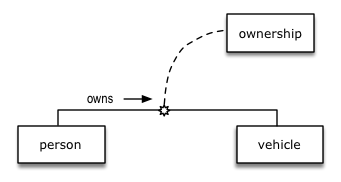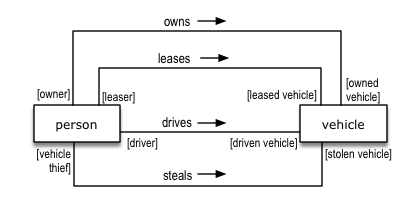ConceptSpeak™ (Part 4): Nouns Based on Verbs — Objectifications & Roles
Speaking the Language of the Business with Concept Models
A concept model comprises a set of concepts and the structural relations between those concepts. ConceptSpeak™ is a comprehensive and carefully-coordinated set of guidelines and techniques for designing a concept model.[1] The conventions of ConceptSpeak follow the Object Management Group's (OMG's) Semantics of Business Vocabulary and Business Rules (SBVR).[2] In this in-depth series, Ron Ross presents ConceptSpeak's highly-disciplined approach for creating concept models based on well-defined elements of structure.
As the previous parts of this series explained[3] the richness of your concept model and the related vocabulary for expressing knowledge arises in large measure from the verb concepts you define. What hasn't been discussed is that the meanings of many of your nouns — more than you might imagine — are tied inextricably to verb concepts. You can expand the precision and expressive power of your vocabulary dramatically by understanding and exploiting these natural connections.
There are two fundamental ways in which nouns arise from verb concepts: objectification and verb-based role. The former addresses the whole verb concept all at once; the latter addresses one noun concept at a time in a verb concept. This part of the series discusses each in turn.
Objectification
In concept models, to objectify means to cause a verb concept as a whole to become or to assume the character of a noun concept.[4] The qualification as a whole is key. Objectifying addresses the verb concept as a whole, no matter how many noun concepts are involved.
The noun concept that results from objectifying a verb concept is called an objectification. In natural language, this occurs frequently, for example:
- The verb concept person owns vehicle might be objectified as ownership.
- The verb concept company sponsors event might be objectified as sponsorship.
- The verb concept party pays invoice might be objectified as payment.
Instances of objectifications, just like instances of the verb concepts they objectify, always exist in the real world (universe of discourse). When you say ownership, for example, picture me standing next to my red car in the carport of my house, waving a car title.
It is important to be very clear about when an instance of an objectification exists. It exists if and only if an instance of the objectified verb concept exists. For example, if an instance of person owns vehicle exists, then an instance of ownership exists. Why? Because they are one and the same. By objectifying a verb concept, you have simply added a new term to your vocabulary. The real questions are whether the term is useful, and does it mean what you think it means.
Objectifying a verb concept — in other words, picking a noun to designate a verb concept — is always optional. In fact, caution needs to be exercised; objectifying a verb concept doesn't necessarily produce the meaning you intended for the noun.
As an example[5] consider person leases vehicle. The term for its objectification that probably first comes to mind is 'lease' (or 'vehicle lease'). Yet when you use that term, the meaning it invokes is a legal document signed by the parties. 'Lease' in that regard is like car title — a different concept than the intended objectification. Ask yourself, "Do I really need this objectification?" After all, when you need to talk about instances in a sentence, you can simply say "a person leasing a vehicle" (or "a vehicle being leased by a person").
Objectification is represented in a concept model diagram as in Figure 1.

Figure 1. Concept model diagram showing objectification.
Note on ConceptSpeak Notation
As always, in a concept model diagram the starburst symbol indicates 'verb concept', in this case person owns vehicle. The dashed line from the starburst connects the verb concept to its objectification, ownership. Since ownership is a noun concept, the term is shown within a box.
While the example given illustrates the objectification of a binary verb concept, a verb concept of any arity can be objectified in this fashion.
Verb-Based Role
Suppose I say "Lions hunt zebras." Lions and zebras participate very differently in this connection (as zebras know all too well!). Specifically, the lions play the part hunter, and zebras play the part prey. If the verb concept is correct and the wording not misleading, there's not much choice about that interpretation.
Hunter and prey are examples of verb-based roles.[6] A verb-based role is a noun concept that reflects the part (or 'role') that instances of some other noun concept play in the specific context of a verb concept. In the case of "Lions hunt zebras." each lion that hunts is an instance of the verb-based role hunter, and each zebra that is hunted is an instance of the verb-based role prey.
Let's revisit the four verb concepts discussed earlier for person and vehicle (repeated in the left column of the table below). What might you call a person and a vehicle involved in instances of each of the four verb concepts? Possible verb-based roles appear in the two columns on the right, respectively.
verb concept
What might you
call the person?What might you
call the vehicle?person owns vehicle
vehicle owner or owner
owned vehicle
person leases vehicle
vehicle leaser or leaser
leased vehicle
person drives vehicle
driver or operator
driven vehicle
person steals vehicle
vehicle thief or thief
stolen vehicle
The designations for verb-based roles are always based on nouns and always considered terms. As entries in the table above illustrate, such terms can be qualified — e.g., stolen vehicle. Sometimes, but not always, the qualification directly reflects the verb symbol — e.g., stolen reflects steals in person steals vehicle. Terms for verb-based roles can also have synonyms. For example, the role of driver could also be termed operator.
Some questions you should ask: Are all owners actually vehicle owners within the scope of the concept model? Can a person be an owner of something else — for example a house? As specified in this example, owner always means vehicle owner. Is that likely to cause confusion? Would vehicle owner be a better choice?
The nouns and noun phrases suggested as verb-based roles in the table above are not all necessarily good or useful designations.[7] Like any other term, the simple test of a role noun should be "Is this new term going to be useful in our business communication?" The following sample business rule illustrates how the verb-based role term provides a concise, easily-understood statement.
Business Rule: A parking citation may be given only to the owner of a vehicle.
But let's suppose for the moment all the new nouns in the table above are deemed useful for business communications. How might you represent them in a concept model diagram? Figure 2 illustrates all eight verb-based roles.

Figure 2. Concept model diagram showing verb-based roles involving people and vehicles.
The four verb concepts above happen to be binary, but verb-based roles apply to unary and n-ary verb concepts too, as Figure 3 illustrates.

Figure 3. Concept model diagram showing verb-based roles for unary and for n-ary verb concepts.
Note on ConceptSpeak Notation
In a concept model diagram, each verb-based role appears in brackets close to the noun concept that it reflects in a given wording. For example, one verb concept diagrammed in Figure 2 is worded: leased vehicle is leased by leaser. A term in brackets in the diagram (e.g., 'leaser') is simply a more specific term that can be used to refer to a person when that person is leasing a vehicle.
References / Notes
[1] Extracted from Business Knowledge Blueprints: Enabling Your Data to Speak the Language of the Business, by Ronald G. Ross, 2020.
http://brsolutions.com/business-knowledge-blueprints.html![]()
[2] Refer to the SBVR Insider section of BRCommunity.com for more information about SBVR. SBVR was initially published in January 2008 by the Object Management Group (OMG). Its central goal is to enable the full semantics of business communication (including business rules) to be captured, encoded, analyzed for anomalies, and transferred
between machines.![]()
[3] Ronald G. Ross , "ConceptSpeak™ (Part 3): Verb Concepts in Concept Models," Business Rules Journal, Vol. 22, No. 3, (Mar. 2021)
URL: http://www.brcommunity.com/a2021/c062.html![]()
[4] The Merriam-Webster Unabridged Dictionary definition of objectify is [1a]: to cause to become or to assume the character of an object. ![]()
[5] Things can go badly out of sync when objectifying a verb concept. Business Knowledge Blueprints (op cit) has an in-depth discussion of various aspects to consider when deciding to objectify a verb concept in a concept model (pp. 166-171). ![]()
[6] In SBVR, verb-based roles are called verb concept roles. ![]()
[7] An in-depth discussion of how to decide when to use a verb-based role is out of scope for this article, but
Business Knowledge Blueprints (op cit) has a comprehensive examination of the question of whether the term proposed for any given verb-based role is a good one, or even a useful one (pp. 158-162). ![]()
# # #
About our Contributor:
Online Interactive Training Series
In response to a great many requests, Business Rule Solutions now offers at-a-distance learning options. No travel, no backlogs, no hassles. Same great instructors, but with schedules, content and pricing designed to meet the special needs of busy professionals.










How to Define Business Terms in Plain English: A Primer
How to Use DecisionSpeak™ and Question Charts (Q-Charts™)
Decision Tables - A Primer: How to Use TableSpeak™
Tabulation of Lists in RuleSpeak®: A Primer - Using "The Following" Clause
Business Agility Manifesto
Business Rules Manifesto
Business Motivation Model
Decision Vocabulary
[Download]
[Download]
Semantics of Business Vocabulary and Business Rules